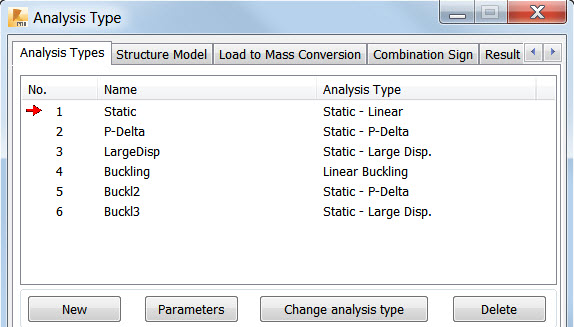Name change for geometrically-nonlinear analyses ('P-Delta' and 'Large displacements')
- "Non-linear" becomes P-Delta.
- "P-delta" becomes Large displacements.
This change affects a number of dialogs in the program.
- When the model contains material or structural nonlinearities.
- In the case of a nonlinear analysis, such as P-Delta or Large displacements analysis.
In order to differentiate the source of the nonlinearity, the description of the analysis now clearly identifies each type of nonlinearity.
For example, in the case of a linear elastic model, the linear P-Delta and Large displacement analyses are displayed in the list of load cases as Static - Linear, Static - P-Deltaand Static - Large disp..

If the nonlinearity is introduced in the model, then the analyses are displayed as Nonlinear Static, Nonlinear Static - P-Delta, Nonlinear Static - Large Disp.
Wind profiles for wind loads simulation
- The possibility to create and save several wind profiles for a wind load simulation.
- A velocity factor increased to 5.00.
- The possibility to adjust the height of the wind profile.
- A graphic representation of the virtual wind tunnel.
See Wind simulation dialog for more details on the Wind profile tab.
The wind profile tab also allows you to load previously saved wind profiles.

See Create a wind profile and Load a Wind Profile.
Wind loads for structures with parapets
In order to apply the appropriate pressure coefficients on the different zones of structures with parapets, the Eurocode-based codes (EN 1991-1-4 (7.4.1)) have been updated. These changes also include specific cases such as the French National Annex NA:2008-03.
Solver changes
A new version of the multithreaded Intel® solver Pardiso has been implemented. This new solver is enabled by default for models with more than 5000 dofs, providing that the automatic solver option is selected in the Job Preferences. This new solver takes advantage from multi-core processors to provide a faster resolution of calculations, and delivers enhanced support of instabilities.
For more information see Multithreaded solver.